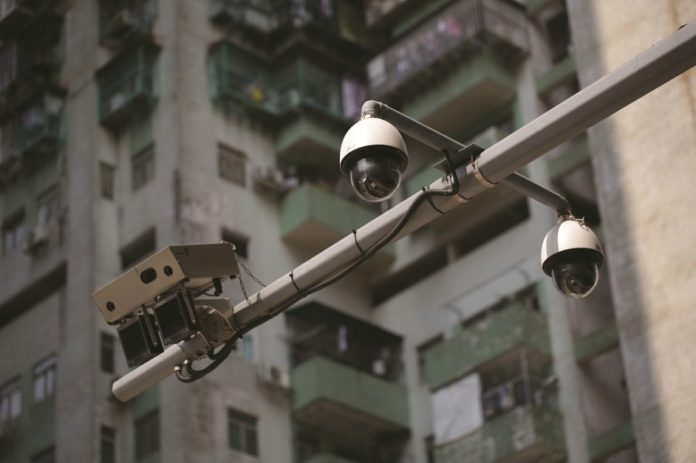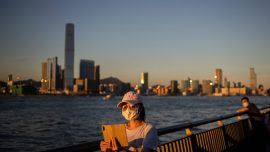After first installing surveillance cameras in the city three years ago amid concerns in society, the government now plans to introduce facial recognition technology to the system
Which place in the world has the highest number of surveillance cameras? It’s a no-brainer question with a simple answer: China. Two years ago, the world’s second-largest economy proudly announced it was building ‘the world’s biggest camera surveillance network’ with 400 million new cameras to be installed in the next three years.
Macau, meanwhile, is closely following in the footsteps of the motherland. The gambling enclave first installed surveillance cameras in public places in 2016, with all 1,620 cameras to be deployed in four phases as part of the so-called Sky Eye system. The last phase of 800 Sky Eye cameras will be ready in the first quarter of 2020 in isolated places and low safety areas.
But the Macau Administration is not stopping there — it is planning to incorporate more cameras with facial and car plate recognition functions, a move that is further sparking worries by some in civil society.
“The Sky Eye surveillance system in Macau, with foreword looking standards and requirements, is one of the most advanced surveillance systems in the world,” said the Commissioner-General of the Unitary Police Service, Ma Io Kun, three years ago. He already hinted at the time that facial recognition functions could be added to the system, with “great compatibility and capabilities”.
Three years later, the local police have recently revealed that 200 of the 1,620 surveillance cameras to be incorporated will inorporate the relevant functions — 100 with facial recognition technology and 100 with car plate recognition technology — with 100 to be tested in the first quarter of 2020.
The Unitary Police Service justify this as being ‘more efficient for police to prevent and combat crime, thus enhancing the abilities of police against crime’, once the cameras are equipped with these technologies. According to official data, the Sky Eye surveillance system has helped police investigate over 2,700 cases in the past three years, with 484 cases in 2017, 1,063 last year, and over 1,200 in the first half of 2019.

Watchdog consulted
“Facial recognition really helps combat crime as police do not have to manually watch surveillance videos to identify suspects, but it leads to higher risks of abuse,” says political commentator Ron Lam U Tou, adding that there are still not enough details on how the police will make use of facial technology.
Currently, the surveillance system here has to comply with the video surveillance law in public places, which came into force in 2012 and mandates police must consult the Office for Personal Data Protection beforehand.
In the face of society’s concerns about the latest police initiative, the data protection office issued the following statement:
‘The police and the security department have consulted with the Office [on facial recognition in surveillance cameras] for some time, and they have made different proposals, some of which the Office has turned down after thorough consideration and some of which have advised on how to improve the content.’
Citing a robbery as an example, the watchdog said facial recognition should only be used in three situations to assist police: after a robbery occurs, police can use facial recognition to determine the whereabouts of a suspect in recorded images once his or her identity is confirmed; the police can identify the suspect in recorded images with the help of technology by matching existing police data on a group of possible suspects; and the technology can be employed to analyse recorded images to determine whether there is an abnormally high frequency of appearances of an individual in the location the robbery has taken place.
The data protection office stressed that police officers can currently do all these manually and that facial technology will only be used to enhance efficiency.
Supervision
But Mr. Lam remains unconvinced with the watchdog’s answer.
“I still don’t see any clauses in the law on public video surveillance talking about facial recognition, and the data protection office should divulge more about the legal support for the use of facial technology,” he observes. “There should be an independent and credible mechanism in supervising [how police use surveillance].”
Although the video surveillance law stipulates penalties for breaches, there is an apparent lack of regular checks to ensure Sky Eye is not abused, the political commentator noted.
The data protection watchdog, or a new third-party body, should regularly conduct checks on police usage of the system and publicise the relevant information on a regular basis, Lam added, noting that “only with a sound supervision mechanism can the public have faith.”
Exchanges with Mainland
While some are wary of the surveillance system, some want the police to go even further. In a recent enquiry, legislator Mak Soi Kun hailed the effectiveness of the system in safeguarding the prosperity of Macau. In the face of new types of crime, he urged that “to better safeguard the national interest and rights of residents, the Administration should upgrade and improve the Sky Eye system to the level of Skynet.”
Skynet – the name of ‘the world’s biggest camera surveillance network’ the central government has proudly developed over the past few years in Mainland China for tracking down criminals with the employment of technologies like facial recognition, artificial intelligence, big data and others – has been accused by human rights workers of being a vehicle for clamping down on opponents and naysayers.
One of Macau’s largest pro-establishment associations – the General Union for Neighbourhood Associations – also advocates new surveillance technologies be adopted, adding police should actively communicate with the public on any concerns. Given Macau’s large influx of tourists, police should enhance exchange and co-operation with the Ministry of Security in Mainland China to introduce more advanced technologies to combat and prevent crime here, they say.

Transparency
In addition to the existing plan of 1,620 cameras, local police intend to launch the fifth and sixth phases of Sky Eye, positioning an additional 980 cameras around the city. A study of the locations of the two new phases will be completed by the first quarter of next year, with cameras to be operational by 2022 and 2023, respectively, the police added.
Icarus Wong Ho Yin, a founder of the Hong Kong-based Civil Rights Observer group, criticises the lack of transparency in the supervision of the Macau surveillance system.
“Before launching any new means for maintaining public safety, any Administration should thoroughly consider the freedom and privacy of residents,” he says. “There should be a balance between security and privacy, when the police seek to prevent and combat crime . . . Security in a totalitarian regime will be the best as the Administration has a clear grasp of everyone in society, but it will be done at the expense of freedom and privacy.”
Over MOP321m allocated to CCTV surveillance
The government has so far spent over MOP321.5 million (US$40.19 million) in the four phases of Sky Eye, installing 1,620 surveillance cameras around the city, according to Official Gazette dispatches.
The most expensive Sky Eye contract is the purchase and installation of cameras in the second and third phases, for which the government paid MOP88.68 million to Companhia de Telecomunicações de Macau, S.A.R.L. (CTM). The city’s largest telecommunications operator was paid an additional MOP20.7 million for more cameras in the second and third phases.
CTM has so far received MOP241.57 million for servicing Sky Eye, including MOP132.18 million for providing optical fibre video signal transmission services for the cameras in the first three phases.
The government also granted MOP62.51 million to Detechion Security System Macau Co. Ltd. – a subsidiary of Golden Dragon Group Co. Ltd. headed by businessman and political heavyweight Chan Meng Kam – for the purchase and installation of first phase surveillance cameras.
There are no financial details about the fourth phase of the project, besides a MOP3.8 million contract for Civil Engineering Consulting Company Limited to draft a development plan.

Details of Surveillance Cameras
| Number of Cameras | Location | Operational Status | Total Investment | |
| Phase 1 | 219 | Vicinity of border checkpoints | Installed | MOP112.54m |
| Phase 2 | 263 | Major thoroughfares and transportation hubs | Installed | MOP205.16m |
| Phase 3 | 338 | Tourist attractions, major facilities, crime spots, | Installed | |
| Phase 4 | 800 | Isolated places and low safety areas | 1Q2020 | MOP3.8 m* |
| Phase 5 | 300 | N/A | 2022 | N/A |
| Phase 6 | 680 | N/A | 2023 | N/A |
| Total | 2,600 | N/A | N/A | MOP321.5 million* |
*Provisional numbers with amount to be increased
Facial recognition technology for casino security only
While the Macau Government plans to introduce facial recognition technology to the city’s public surveillance cameras, local casino operators are also considering the introduction of similar technology.
The gaming regulator – the Gaming Inspection and Co-ordination Bureau (DICJ) – recently confirmed that some equipment suppliers were testing facial recognition technology devices in the casinos of ‘two to three’ gaming operators.
Authorities, however, stress that the devices are only used for security purposes, and that they are prohibited from using them to gain insights into the behaviour of gamblers as claimed in a recent article by financial news agency Bloomberg.
DICJ added that the installation of any electronic surveillance equipment in casinos must obtain prior approval.
























